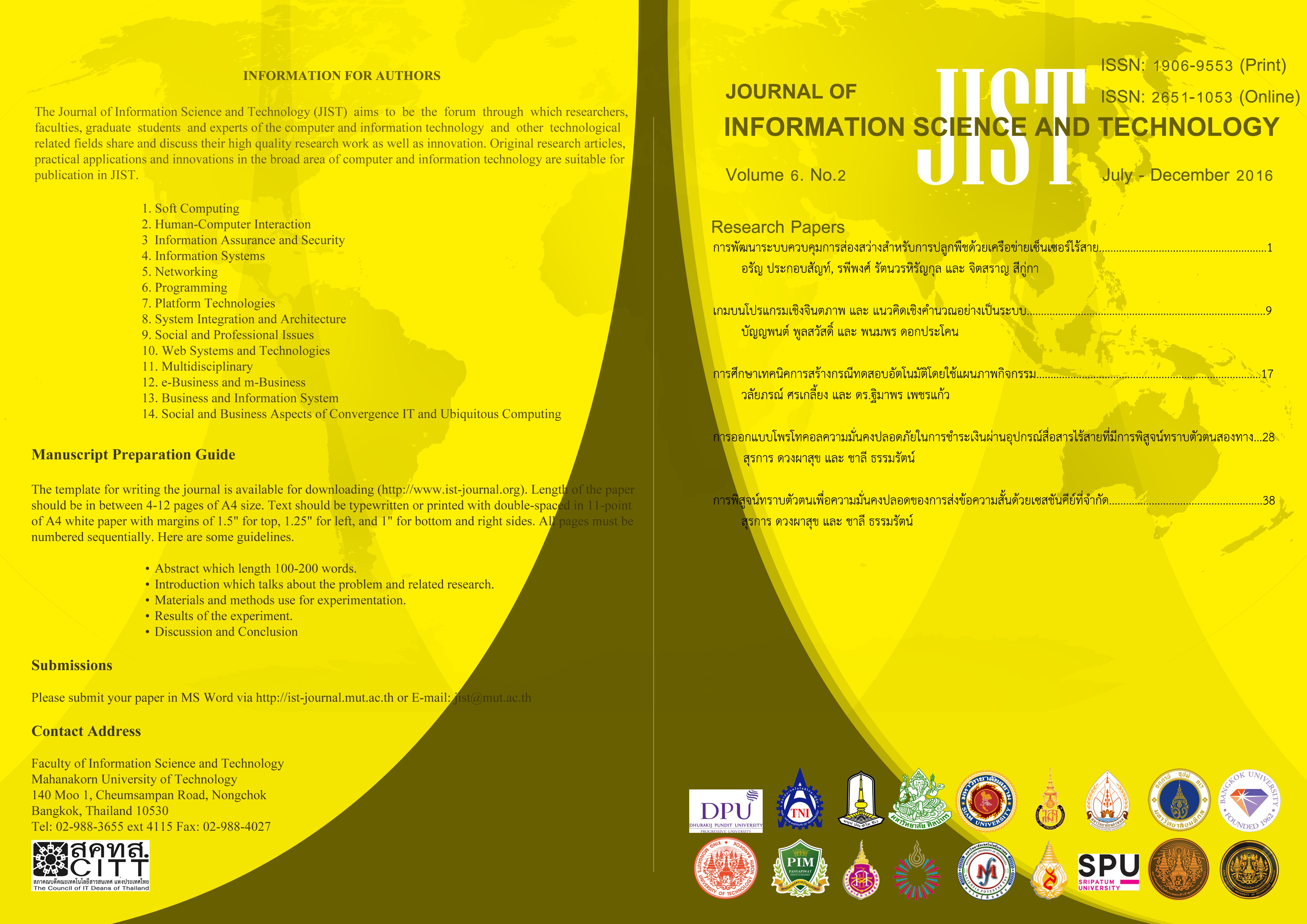Study of Automatic Test Case Generation Techniques using UML Activity Diagram
Main Article Content
Abstract
- There are many techniques to generate test case from UML activity diagram, this brings about the difficulty in selecting the appropriate technique for different types of program. In this paper, we compared the eight algorithms of the automatic test case generation: Round-Robin, Condition-Classification Tree, Activity Tree, Intermediate Testable Model, Activity Dependency Table and Activity Dependency Graph, Test Path Reduction, Activity Convert Grammar, and Activity Flow Graph. The results showed that (1) in the aspect of covering all paths, almost all algorithm could generate all possible paths while the Round-Robin could generate too many paths, (2) in the aspect of covering basis paths, all eight algorithms could generate all basis paths, (3) in the aspect of the complex model activity diagram that we constructed, the Activity Convert Grammar could generate too many paths, it has 44.23% of paths that exceed the number of target path, the Test Path Reduction could generate too few paths, it has 65.38% of paths lower than the number of target paths, and the Activity Flow Graph could generate the amount of paths as same as the expected paths, it has only 1.92% of paths that exceed the number of target paths.
Article Details
This work is licensed under a Creative Commons Attribution-NonCommercial-NoDerivatives 4.0 International License.
I/we certify that I/we have participated sufficiently in the intellectual content, conception and design of this work or the analysis and interpretation of the data (when applicable), as well as the writing of the manuscript, to take public responsibility for it and have agreed to have my/our name listed as a contributor. I/we believe the manuscript represents valid work. Neither this manuscript nor one with substantially similar content under my/our authorship has been published or is being considered for publication elsewhere, except as described in the covering letter. I/we certify that all the data collected during the study is presented in this manuscript and no data from the study has been or will be published separately. I/we attest that, if requested by the editors, I/we will provide the data/information or will cooperate fully in obtaining and providing the data/information on which the manuscript is based, for examination by the editors or their assignees. Financial interests, direct or indirect, that exist or may be perceived to exist for individual contributors in connection with the content of this paper have been disclosed in the cover letter. Sources of outside support of the project are named in the cover letter.
I/We hereby transfer(s), assign(s), or otherwise convey(s) all copyright ownership, including any and all rights incidental thereto, exclusively to the Journal, in the event that such work is published by the Journal. The Journal shall own the work, including 1) copyright; 2) the right to grant permission to republish the article in whole or in part, with or without fee; 3) the right to produce preprints or reprints and translate into languages other than English for sale or free distribution; and 4) the right to republish the work in a collection of articles in any other mechanical or electronic format.
We give the rights to the corresponding author to make necessary changes as per the request of the journal, do the rest of the correspondence on our behalf and he/she will act as the guarantor for the manuscript on our behalf.
All persons who have made substantial contributions to the work reported in the manuscript, but who are not contributors, are named in the Acknowledgment and have given me/us their written permission to be named. If I/we do not include an Acknowledgment that means I/we have not received substantial contributions from non-contributors and no contributor has been omitted.
References
2. S. Kansomkeat, P. Thiket and J. Offutt, “Generating test cases from UML activity diagrams using the Condition-Classification Tree Method”, In Proceedings of 2nd International Conference on Software Technology and Engineering (ICSTE), Vol. 1, October. 2010. pp. 62-66
3. R. K. Swain, V. Panthi, D. P. Mohapatra, P. K. Behera, “Prioritizing test scenarios from UML communication and activity diagrams”, Innovations in Systems and Software Engineering, Vol. 10, Issue 3, September 2014, pp. 165–180
4. A. Nayak and D. Samanta, “Synthesis of Test Scenarios using UML Activity Diagrams”, Software and Systems Modeling (SoSyM). Vol.10 Issue.1, February. 2011. pp. 63-89
5. C. Chouhan, V. Shrivastava, P.S. Sodhi, “Test Case Generation based on Activity Diagram for Mobile Application”, International Journal of Computer Applications, Vol. 57, No. 23, November. 2012.
6. P. N. Boghdady, N. L. Badr, M. Hashem and M. F. Tolba, “An Enhanced Test Case Generation Technique Based on Activity Diagrams”, In Proceedings of the Seventh International Conference on Computer Engineering and Systems (ICCES). November-December 2011. pp. 289-294
7. K. Pechtanun and S. Kansomkeat, “Generation Test Cases from UML Activity Diagram Based on AC Grammar”, International Conference on Computer and Information Science (ICCIS), Vol. 2, September 2012. pp. 895-899
8. R. K. Swain, V. Panthi, P. K. Behera, “Generation of Test Case using Activity Diagram”, International Journal of Computer Science and Informatics, Vol. 3, Issue. 2, November 2013. pp. 1-10
9. P. N. Boghdady, N. L. Badr, M. Hashem and M. F.Tolba, “A Proposed Test Case Generation Technique Based on Activity Diagrams”, International Journal of Engineering & Technology IJET/IJENS, Vol. 11, No. 03, June 2011. pp. 37-57
10. P. N. Boghdady, N. L. Badr, M. Hashem and M. F.Tolba, “An Enhanced Technique for Generating Hybrid Coverage Test Cases Using Activity Diagrams”, The 8th International Conference on INFOrmatics and Systems (INFO2012), May. 2012. pp. 20-28



